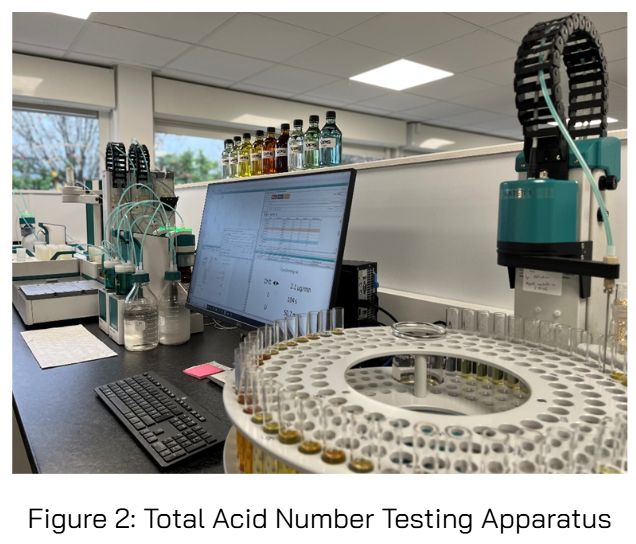How Healthy Are Your Electrical Assets?
The Critical Role of Fluid Quality Testing in Electrical Asset Management
By James Robinson, VPS Power Business Manager
Introduction
Transformer oil, also known as insulating fluid, is a crucial component in the operation and maintenance of electrical assets. It serves as an insulating medium, cooling agent, and arc quencher, protecting the transformers’ internal components from damage. Over time, transformer oil can degrade due to various factors such as age, contamination, and thermal stress. Regular fluid quality testing is essential to ensure the oil's reliability and the overall health of the asset.
Why Conduct Fluid Quality Testing?
1. Early Detection of Issues:
Regular oil testing can detect issues at an early stage, allowing for timely corrective action before they escalate into major problems. This helps prevent costly downtime and asset failures.
2. Extending Transformer Life:
By identifying and addressing issues early, oil testing can help extend the life of the transformer, reducing maintenance costs and minimizing downtime.
3. Enhancing Safety:
Transformer oil testing can help identify potential safety hazards, such as the presence of contaminants, which can lead to fires or explosions.
4. Improving Reliability:
Ensuring the quality and reliability of the transformer oil through regular testing improves the overall reliability of the asset, reducing the risk of failures and improving power supply reliability.
Types of Tests Performed on Transformer Oil
1. Colour and Appearance Tests:
- Purpose: Assesses the degree of oxidation and contamination in the oil.
- Method: The colour test involves comparing the oil sample to a colour standard, while the appearance test determines the presence of solid particles or impurities such as free water.
- Significance: Darkening of the oil or reduced clarity can indicate contamination, degradation, or internal arcing.
2. Dielectric Strength or Breakdown Voltage (BDV) Test:
- Purpose: Measures the oil’s ability to withstand electric stress, ensuring that it can provide adequate insulation.
- Method (IEC 60156): An oil sample is placed in a cell fitted with two electrodes, and a gradually increasing voltage is applied to the oil until breakdown occurs.
- Significance: A high breakdown voltage indicates good insulating properties, while a low breakdown voltage suggests contamination or degradation.

3. Moisture Content Analysis:
- Purpose: Measures the amount of moisture in the oil, which can significantly impact its dielectric strength.
- Method (IEC 60814): Karl Fischer titration is commonly used, involving a chemical reaction that quantifies the water content in the oil sample.
- Significance: High moisture content can lead to reduced dielectric strength and accelerates the deterioration of insulating oil and paper insulation.
4. Acid Number (Neutralization Number) Test:
- Purpose: Quantifies acidic components in the oil, which result from oxidation.
- Method (IEC 62021-1): The oil sample is titrated with a base, and the amount required to neutralize the acids is measured.
- Significance: A high acid number indicates significant oil degradation, which may eventually form sludge.

5. Dielectric Dissipation Factor (Tan Delta) and Resistivity Tests:
- Purpose: DDF is a measure of the dielectric losses, or the amount of energy dissipated as heat. Resistivity is a measure of the oil’s ability to resist electrical current flow. Both are indicators of contamination in the oil.
- Method (IEC 60247): The oil is heated to a set temperature. AC voltage is applied for tan delta then DC voltage is applied for resistivity.
- Significance: High resistivity indicates good oil and reduced resistivity signals contamination. Low dissipation factor indicates good oil and increased dissipation factor signals contamination. Very sensitive to the presence of ageing products, polar contaminants, and colloids.
6. Interfacial Tension (IFT) Test:
- Purpose: Assesses the oil’s cleanliness and degree of contamination by measuring the tension at the interface between oil and water (which do not mix).
- Method (IEC 62961): A tensiometer measures the force required to detach a ring or plate from the oil-water interface.
- Significance: Low IFT values indicate the presence of polar contaminants or degradation products, signalling oil ageing.
Additional investigative testing is also available such as particle count, corrosive sulphur and DBDS.
Benefits of Regular Fluid Quality Testing
1. Maximising Investment:
Regular maintenance through fluid analysis helps keep assets in optimal condition, this proactive approach can also save money on expensive repairs or replacements by identifying problem areas early.
2. Preventing Untimely Failures:
Routine testing provides important data on the assets condition and operational trends. This information can be used to improve the equipment’s performance and extend its working life, offering better returns on investment.
3. Ensuring Compliance:
Regular testing ensures compliance with industry standards and regulations, which is crucial for maintaining the safety and reliability of electrical systems.
Conclusion
Fluid quality testing of transformer oils is an essential practice for maintaining the health and reliability of electrical assets. By conducting regular tests, you can detect issues early, extend the lifespan of your electrical assets, enhance safety, and improve overall reliability. This proactive approach to maintenance ensures that electrical assets operate efficiently and effectively, providing a stable and reliable power supply.
Ready to protect your transformers?
Contact VPS Power today at power@vpsveritas.com to learn more about our comprehensive transformer oil testing services and how we can help you maintain a reliable power grid.
 Search
Search
 Customer
Customer